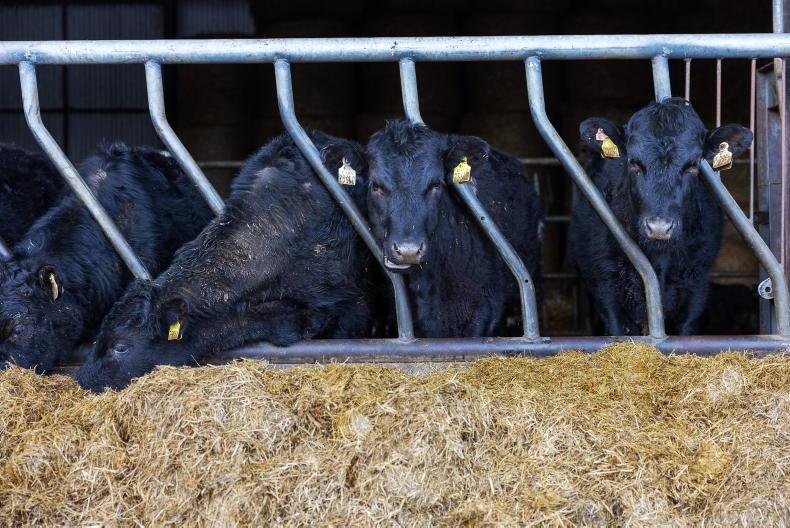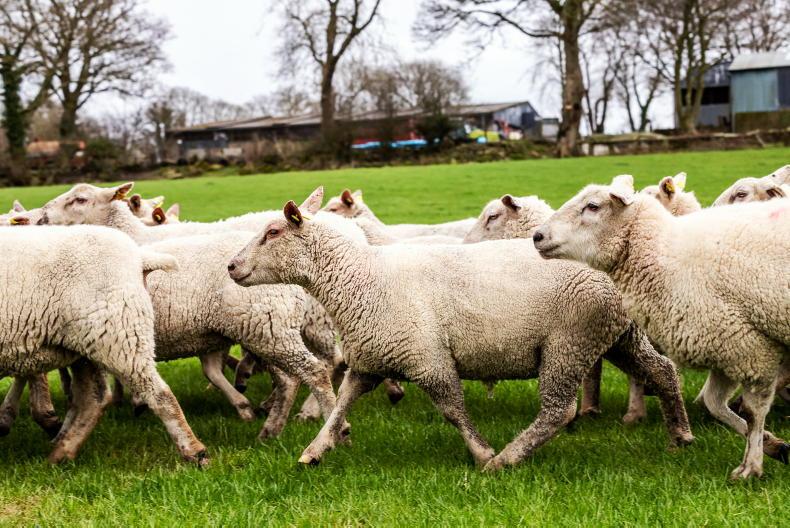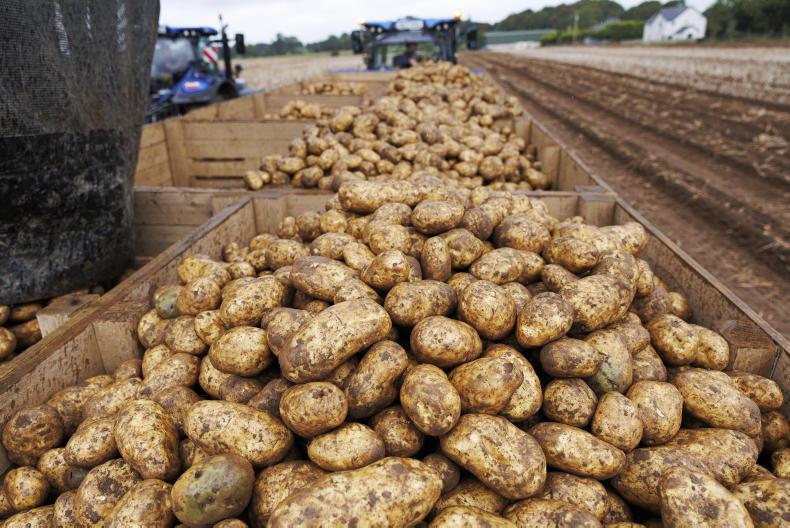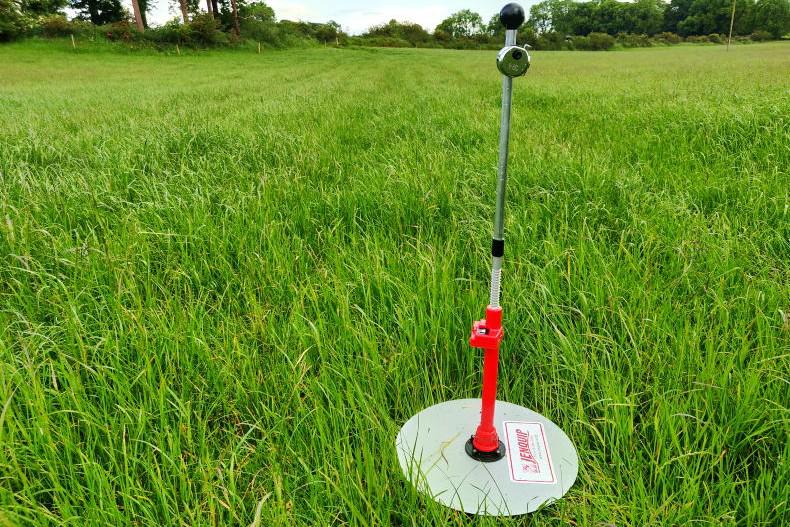A long running dairy trial at the Solohead Research Farm in Co Tipperary shows that clover-based swards can deliver significantly lower greenhouse gas (GHG) emissions and significantly higher profit margins.
Speaking at an AgriSearch seminar in Cookstown last Thursday, Teagasc researcher Dr James Humphreys explained that when results of trials on clover versus fertiliser nitrogen (N)-based systems were published in 2012, there was very little difference in profitability. As a result, there was little incentive for farmers to adapt their systems.
However, in recent years, researchers have been able to maintain a similar level of output in the zero N, clover-based system when compared to one that uses a high fertiliser N input of 270kg/ha. With similar output and high fertiliser prices, the economics have fundamentally changed.
The trial at Solohead compares three systems. As well as high N and zero N treatments, there is a third scenario where N is mainly applied in the spring (105kg N/ha in total), with about 23% clover content in swards.
That compares to 11% clover content in the high N treatment and 30% clover where no N is applied. There are 27 cows in each treatment, with a target to be stocked at 2.5 cows/ha, and producing around 6,000l per cow on 550kg of concentrate.
Growth
From 2017 to 2021, the high N system grew an average of 15.7t dry matter per hectare (DM/ha), of which 1.6t DM was clover, compared to 15.1t DM/ha in the zero N treatment where 4.1t DM was from clover.
“The more N fertiliser we put on, the less N we fixed, and the less fertiliser we put on, the more we fixed. The clover seems to be performing year-on-year. We are getting confidence in it now,” said Humphreys.
Based on total herbage growth, the researchers worked out that they could stock at 2.56 cows/ha in the high N treatment, compared to 2.45 cows/ha in the zero N, high clover alternative.
Scaling up to a 50ha farm, it would mean 128 cows can be carried in the high N scenario, and 123 cows where no N is used. GHG emissions per litre come out at 0.88kg/l (12.5t/ha) and 0.69kg/l (9.3t/ha) respectively, which is a 25% reduction.
Margins
Despite having slightly lower output in the zero N scenario, input costs are much reduced, resulting in higher margins per hectare.
Net margin, which includes a full labour cost, is €1,513/ha in the high N treatment versus €1,733/ha where no N was used.
However, those margins do not take account of the spike in fertiliser costs in 2022.
“The prices used [in the net margin calculation] are the average prices between 2019 and 2021. Expenditure on N fertiliser went from €13,000 down to zero.
“If we put in the same figures this year, it would be €35,000 down to zero. It is a big difference this year,” said Humphreys. He maintained that clover was the “big driver” in having lower emissions and higher net margins, and that a similar performance was now being seen in a group of commercial farms working alongside the Solohead project over the last couple of years. “That is very reassuring from my point of view,” said Humphreys.
Lessons from Solohead for NI farmers
The Teagasc research farm at Solohead might be at least 200 miles south of most farms in NI, but according to James Humphreys, land type is not dissimilar to the North, with 20cm of topsoil above a heavy clay base.
Enormous challenge to meet climate targets
Approximately 10 years ago, agriculture in ROI accounted for around 30% of total emissions, but with dairy expansion since the end of the EU milk quota regime, that figure is now 37%. Rising GHG emissions from Irish agriculture need to be set against new Government targets announced in August 2022 that require emissions from agriculture to fall by 25% (when compared to 2018) by 2030.
Describing it as an “enormous challenge”, James Humphreys maintained that it has put farming, and dairy in particular, in the spotlight. “The pressure is on,” he said.
Obstacles in switch to clover
Clover requires a change to management, but the biggest obstacle is to persuade farmers to stop applying N fertiliser, James Humphreys told attendees at the AgriSearch event.
He said that fertiliser N “drives out clover”, but added that white clover in particular is shallow rooted, so it does need regular applications of other nutrients, especially potassium (K).
At Solohead, 15 units of K is applied to grazing swards four times per year.
The target at the farm is to grow 5t of clover DM/ha per year, which should in turn fix up to 240kg of N into the sward.
Typical seed mixes when establishing a new sward incorporate white clover varieties Barblanca and Coolfin, as well as Milvus, an older red clover variety that tends to have better persistence than other red clovers.
The main perennial ryegrass used is the tetraploid, Astonenergy, which is palatable to stock and is therefore eaten out close to the ground.
Spray
Humphreys advised that some 10:10:20 can be applied at establishment, but the key management input is to go on with a clover-safe herbicide post-emergence. While there are some products available in the Republic of Ireland (ROI), choices in NI are currently limited.
In practice, it might be best to establish a new sward without clover, deal with resultant weeds, and then stitch in white clover at a rate of 1.5-2.5kg/ac the following year. However, that is not a suitable alternative if putting in a crop of red clover, which is best sown into a new seedbed. In all cases, soil pH should be above 6.
Clover swards must be tightly grazed in the spring and summer to ensure light gets to the base of the sward. The sward should also be tightly grazed out in the autumn, however continuous grazing over the winter must be avoided.
“Grassland management has changed enormously in the last 20 years – this is just another adaption. It’s just different – you need to work to a new set of rules,” said Humphreys.
Bloat risk needs to be managed
Since working on clover swards over the last 23 years, only three cows have been lost to bloat, so it is a risk that can be managed, suggested James Humphreys. He said the key issue was not to put hungry cows into a high clover sward, where they will tend to graze off the clover leaves sitting on the surface.
In practice, where a farmer is working on four grazings from a paddock, it might be a case of taking three grazings, going on to the next paddock for one grazing and then back to the original sward to graze it out. Alternatively, he said that some farmers put up a strip wire, forcing cows to graze down into the sward, before allowing access to all of the paddock.
“We have used bloat oil, but it is expensive and not particularly useful. Management is a better option,” he said.
Scattering of clover of little use
Also speaking at the AgriSearch event, Dr Liz Genever, an independent beef and sheep consultant from England, said that clover can typically fix 150kg N/ha, but warned it is important to be honest about what a good clover sward actually is.
“If you have got a scattering of white clover in a field, it isn’t going to be fixing that amount of N,” she said.
Clover growth will vary across the year, and a sward with 30% clover in the spring is likely to have 60% clover by the autumn – at 60%, the sward looks like it is dominated by clover.
However, if the sward is dominated by clover in the spring, Genever said she would be worried there isn’t enough grass in the sward. “Grass is driving a lot of the yield,” she said.
Read more
AgriSearch to invest over £400,000 in GrassCheck
Key lessons from clover farms
A long running dairy trial at the Solohead Research Farm in Co Tipperary shows that clover-based swards can deliver significantly lower greenhouse gas (GHG) emissions and significantly higher profit margins.
Speaking at an AgriSearch seminar in Cookstown last Thursday, Teagasc researcher Dr James Humphreys explained that when results of trials on clover versus fertiliser nitrogen (N)-based systems were published in 2012, there was very little difference in profitability. As a result, there was little incentive for farmers to adapt their systems.
However, in recent years, researchers have been able to maintain a similar level of output in the zero N, clover-based system when compared to one that uses a high fertiliser N input of 270kg/ha. With similar output and high fertiliser prices, the economics have fundamentally changed.
The trial at Solohead compares three systems. As well as high N and zero N treatments, there is a third scenario where N is mainly applied in the spring (105kg N/ha in total), with about 23% clover content in swards.
That compares to 11% clover content in the high N treatment and 30% clover where no N is applied. There are 27 cows in each treatment, with a target to be stocked at 2.5 cows/ha, and producing around 6,000l per cow on 550kg of concentrate.
Growth
From 2017 to 2021, the high N system grew an average of 15.7t dry matter per hectare (DM/ha), of which 1.6t DM was clover, compared to 15.1t DM/ha in the zero N treatment where 4.1t DM was from clover.
“The more N fertiliser we put on, the less N we fixed, and the less fertiliser we put on, the more we fixed. The clover seems to be performing year-on-year. We are getting confidence in it now,” said Humphreys.
Based on total herbage growth, the researchers worked out that they could stock at 2.56 cows/ha in the high N treatment, compared to 2.45 cows/ha in the zero N, high clover alternative.
Scaling up to a 50ha farm, it would mean 128 cows can be carried in the high N scenario, and 123 cows where no N is used. GHG emissions per litre come out at 0.88kg/l (12.5t/ha) and 0.69kg/l (9.3t/ha) respectively, which is a 25% reduction.
Margins
Despite having slightly lower output in the zero N scenario, input costs are much reduced, resulting in higher margins per hectare.
Net margin, which includes a full labour cost, is €1,513/ha in the high N treatment versus €1,733/ha where no N was used.
However, those margins do not take account of the spike in fertiliser costs in 2022.
“The prices used [in the net margin calculation] are the average prices between 2019 and 2021. Expenditure on N fertiliser went from €13,000 down to zero.
“If we put in the same figures this year, it would be €35,000 down to zero. It is a big difference this year,” said Humphreys. He maintained that clover was the “big driver” in having lower emissions and higher net margins, and that a similar performance was now being seen in a group of commercial farms working alongside the Solohead project over the last couple of years. “That is very reassuring from my point of view,” said Humphreys.
Lessons from Solohead for NI farmers
The Teagasc research farm at Solohead might be at least 200 miles south of most farms in NI, but according to James Humphreys, land type is not dissimilar to the North, with 20cm of topsoil above a heavy clay base.
Enormous challenge to meet climate targets
Approximately 10 years ago, agriculture in ROI accounted for around 30% of total emissions, but with dairy expansion since the end of the EU milk quota regime, that figure is now 37%. Rising GHG emissions from Irish agriculture need to be set against new Government targets announced in August 2022 that require emissions from agriculture to fall by 25% (when compared to 2018) by 2030.
Describing it as an “enormous challenge”, James Humphreys maintained that it has put farming, and dairy in particular, in the spotlight. “The pressure is on,” he said.
Obstacles in switch to clover
Clover requires a change to management, but the biggest obstacle is to persuade farmers to stop applying N fertiliser, James Humphreys told attendees at the AgriSearch event.
He said that fertiliser N “drives out clover”, but added that white clover in particular is shallow rooted, so it does need regular applications of other nutrients, especially potassium (K).
At Solohead, 15 units of K is applied to grazing swards four times per year.
The target at the farm is to grow 5t of clover DM/ha per year, which should in turn fix up to 240kg of N into the sward.
Typical seed mixes when establishing a new sward incorporate white clover varieties Barblanca and Coolfin, as well as Milvus, an older red clover variety that tends to have better persistence than other red clovers.
The main perennial ryegrass used is the tetraploid, Astonenergy, which is palatable to stock and is therefore eaten out close to the ground.
Spray
Humphreys advised that some 10:10:20 can be applied at establishment, but the key management input is to go on with a clover-safe herbicide post-emergence. While there are some products available in the Republic of Ireland (ROI), choices in NI are currently limited.
In practice, it might be best to establish a new sward without clover, deal with resultant weeds, and then stitch in white clover at a rate of 1.5-2.5kg/ac the following year. However, that is not a suitable alternative if putting in a crop of red clover, which is best sown into a new seedbed. In all cases, soil pH should be above 6.
Clover swards must be tightly grazed in the spring and summer to ensure light gets to the base of the sward. The sward should also be tightly grazed out in the autumn, however continuous grazing over the winter must be avoided.
“Grassland management has changed enormously in the last 20 years – this is just another adaption. It’s just different – you need to work to a new set of rules,” said Humphreys.
Bloat risk needs to be managed
Since working on clover swards over the last 23 years, only three cows have been lost to bloat, so it is a risk that can be managed, suggested James Humphreys. He said the key issue was not to put hungry cows into a high clover sward, where they will tend to graze off the clover leaves sitting on the surface.
In practice, where a farmer is working on four grazings from a paddock, it might be a case of taking three grazings, going on to the next paddock for one grazing and then back to the original sward to graze it out. Alternatively, he said that some farmers put up a strip wire, forcing cows to graze down into the sward, before allowing access to all of the paddock.
“We have used bloat oil, but it is expensive and not particularly useful. Management is a better option,” he said.
Scattering of clover of little use
Also speaking at the AgriSearch event, Dr Liz Genever, an independent beef and sheep consultant from England, said that clover can typically fix 150kg N/ha, but warned it is important to be honest about what a good clover sward actually is.
“If you have got a scattering of white clover in a field, it isn’t going to be fixing that amount of N,” she said.
Clover growth will vary across the year, and a sward with 30% clover in the spring is likely to have 60% clover by the autumn – at 60%, the sward looks like it is dominated by clover.
However, if the sward is dominated by clover in the spring, Genever said she would be worried there isn’t enough grass in the sward. “Grass is driving a lot of the yield,” she said.
Read more
AgriSearch to invest over £400,000 in GrassCheck
Key lessons from clover farms










SHARING OPTIONS